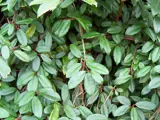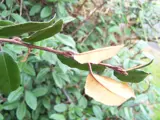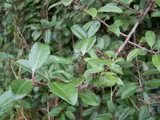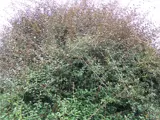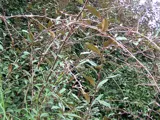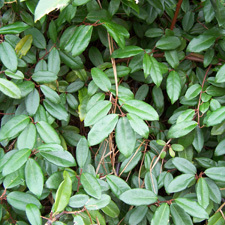 Elaeagnus
Elaeagnus
Common name:Elaeagnus
Botanical name: Elaeagnus x reflexa
Management programme: Advisory
Originates from Japan and introduced to New Zealand as a stock proof hedging and windbreak plant. Its vigorous growth and need for continuous pruning meant that its use is not so common anymore. Elaeagnus been used in the past as a hardy stock proof hedge plant.
Why is it a pest?
- Elaeagnus is considered weedy due to its scrambling habit, suckering roots, nitrogen fixing ability, the fact it is extremely long-lived and not grazed by stock.
- Stems and suckers are usually spread via dumped vegetation.
- Seed can also be spread by possums and goats. However, few plants produce seed and only rarely.
Where is it found?
Elaeagnus is found throughout the Bay of Plenty region. It is often found in abandoned homesteads and neglected farms, forest margins, cliffs, sand dunes and shrubland.
What does it look like?
- Dense, spiny, vigorous, scrambling shrub that grows up to 20m in supporting trees with a very tough, suckering rootstock.
- Stems are long, arching, tough, with young shoots being brown and scaly whilst, older stems often have spines.
- Leaves are evergreen, arranged alternately, hairless above, and silvery or brown and scaly on the underside.
- Small whitish, fragrant, flowers (3mm diameter) are produced in drooping clusters on brown, scaly stalks (up to 7mm long) from March to May.
- Fruit is pale, drupe-like, up to 18mm long, reddish-orange, and oblong (May, September). Each fruit holds one eight-ribbed seed.
What are the rules?
Advisory
The Bay of Plenty Regional Council does not enforce the control of advisory species. It is landowner/occupier responsibility to manage these pests. Council may provide advice on how to manage or control these species if required.
How do you get rid of it?
Recommended:
- Dig out with machinery when possible.
- Stump treatment with glyphosate (250ml/L) or a (100g) picloram + (300g) triclopyr mix/ L or picloram gel.
- Stem injection with glyphosate, metsulfuron-methyl or picloram.
- Frilling with glyphosate (250mL/L) or picloram + triclopyr mix (100g + 300g/ L water)
- Overall spray with glyphosate or metsulfuron-methyl.
Elaeagnus is extremely difficult to control. Follow up treatment will be required. Dispose of any plant and root material at the refuse station in general waste, or leave to rot down in situ.
CAUTION: When using any herbicide or pesticide, PLEASE READ THE LABEL THOROUGHLY to ensure that all instructions and directions for the purchase, use and storage of the product, are followed and adhered to.
Read more on pest control advice, information and regulations.
Images

